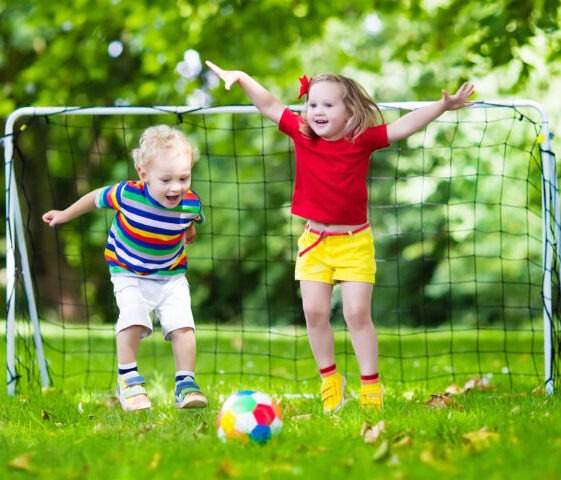Games help make movement fun. Play and laughter can help develop friendship while encouraging physical fitness. Consider each child’s abilities and encourage all children to play by adapting games for children with disabilities and developmental delays.
Play beach ball games.
Beach ball play can be a fun way to encourage control skills such as hitting, kicking, rolling, and catching. Demonstrate hitting the beach ball with different parts of your body. Emphasize safety. Keep beach balls away from the mouth and stay within a safe space.
Set up a maze indoors or out.
Try using large mats folded to stand on end or chairs with sheets draped over the back to form walls. Have one starting point but several exits. Make the path wide enough to accommodate wheelchairs and the walls sturdy enough for a child with visual impairment to feel their way. Place pictures or tactile objects on the walls and give children a picture checklist that they can mark as they find the pictures.
Provide a target for throwing.
Paint a target on the sheet, tie or sew bells onto it, and hang it in a safe place. Let children throw balls or safe beanbags at the target. Encourage children to make the bells ring. Let one child give verbal directions in throwing to a classmate who has visual impairments. Allow a child with poor motor control to get very close to the target.
Try the “freeze” game!
Have each child move their arms and legs and head in time to music. When the music stops, all children freeze in their positions for a few seconds. Play this game with eyes closed, then ask them to open their eyes to see the funny poses.
Lead the children in dancing games
Teach children simple dance moves such as twisting, twirling, spinning, stomping, clapping, or flapping their arms like a chicken. Play music and call out dance moves for students to do. Hold up visual cue cards of the moves for children who may respond better to nonverbal directions. Let children take turns calling out the moves.
Play parachute games.
Have children sit in a circle around a parachute. Ask them to hold on to the edge to complete tasks such as shaking light balls in the middle of the parachute or making waves. Provide an easy-to-grip handle or wrist strap for children who have trouble gripping with their hands. If some children use wheelchairs, play parachute games with other children sitting in their chairs as well to create an even surface.
Have fun with rhythmic ribbons!
Children can wave colorful ribbons in time to music and form patterns with different colors. Use a soft elastic or rubber band to secure a ribbon to the wrist or ankle of a child who lacks motor control.
Look for other ideas related to specific special needs in these resources: Creative Play Activities for Children with Disabilities: A Resource Book for Teachers and Parents, by Lisa Rappaport Morris and Linda Schulz, and Adapted Games and Activities: From Tag to Team Building by Pattie Rouse (Champaign, IL: Human Kinetics).
IEL Resource
- Resource List: Children’s Play – More than Fun and Games


 PDF
PDF